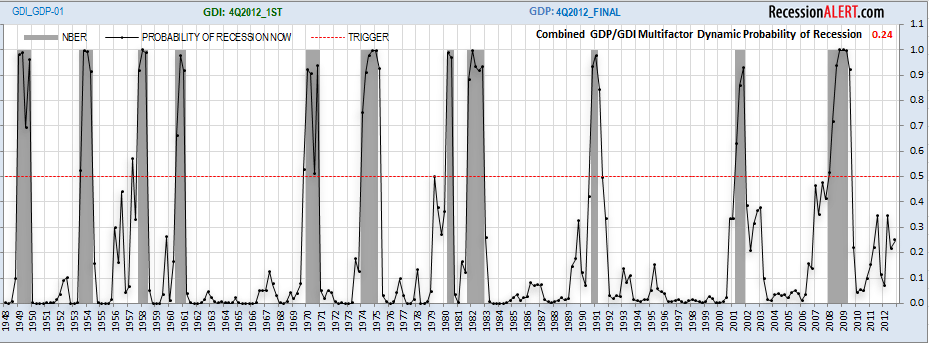With Jeremy Grantham's valuation models suggesting that the average large cap and the average small cap US stock will underperform an A-rated 7-year non-callable tax-exempt bond, it strikes yours truly as the sign of a top or at least topping process when even the bears are bullish. Here is a compendium:
Carter Worth of Oppenheimer is insistent that a correction is due-- but he expects it's onward and upward after that. If so, how can he be sure that a correction is coming, and why should a client take the risk of missing the up-move just to catch what may be as little as a brief 6% decline that could be reversed in less than one bullish week? (
LINK)
More pertinent, Zero Hedge quotes Bob Janjuah- a well-known bear- as predicting new highs-- then the usual call for a crash. But-- new highs! So- stay in is the message, or at least buy the dip. (
LINK)
Perhaps most dramatic is the turnaround from the economic bears ECRI. They have been talking recession since September 2011. In their public commentary introducing their recession call back then, they referenced a dire state of affairs. Something to the effect that if you thought the Great Recession was bad, just wait until you see how bad things will get soon. Now they have changed their tune. They allege that the US is still in a recession, but it's mild, and they point out that in 1945 and 1980, recessions were associated with bull markets in stocks. But what the emphasize is the other modern recession with a bull, not bear stock market- 1927. That's the one they highlight. The message is clear: buy stocks, a massive bull market may await (
LINK).
The well-known bear Gary Shilling, who I believe was predicting a recession both in 2011 and definitely was predicting one for 2012, is out with a series of articles in BBG predicting deflation-- but now it's the "good" deflation. It's the sunniest article, of many, I've ever seen out of him (
LINK). It's called
The Benefits of Chronic Deflation. But it's good deflation!
Richard Russell, who 1-3 years ago was calling our times a depression, worrying about his grandchildren, etc., and who a year-and-a-half ago was espying "gold fever" as gold got to its 2011 peak, is now-- what else-- bullish. Why is he bullish? Silly question. Stocks are going up! Gasp - the industrials are going up and-
mirabile dictu- so are the trannies. Thus,
res ipsa loquitur- buy, baby, buy
. Did you evah-- they printed money, speculators speculated, they speculated in both industrials and transportation stocks-- so, many Dow points higher than when he was bearish, he is now bullish.
These are just some examples. Rosie turned bullish a while ago. So did Tyler of ZH.
The fly in the ointment is that the latest crutch to GDP, the newest potential bubble, is not housing and it is certainly not tech (that was so 20th century)-- it is Federalizing education by calling aid to students "loans". The problem is that many of them can't pay the loans back. This is turning into a decent-sized problem. Then there is the issue that it was recently casually reported at the end of a (what else?) bullish BBG or Reuters article on the wonderful recovery in auto sales that something like 42% of new auto loans were subprime.
If interest rates were really too low, the ubiquitous "they" wouldn't have to resort to this sort of stuff to keep appearances up. Students would get loans to go to school, then they would get jobs, and pay back or their loans. Many of them would not want to waste time in school, because they would prefer just to be working and earning money rather than being bored in school at great expense. But from the standpoint of the current crop of politicians, getting these people in school means they are not counted as unemployed.
So it goes.
There are a few boring stocks I like, such as LNC, which trades way under book value with record and rising earnings and a low P/E. But overall, there's lot of hopium. The US economy- remember that- continues in its prescribed Reinhart-Rogoff pattern of moseying along with several more years of working through the horrible and spectacular collapse of the 2008 period; said collapse made a mockery of many years of financial statements and underlying assumptions about the economy. Thus ZIRP and more ZIRP.
But overall, as Jim Rogers said very recently, those of us of a certain age just watch the bulls running. We can't run fast enough anymore to run with them, and if you short a bull run, you're liable to get trampled, so you just go about your life and let the speculators go about theirs.









